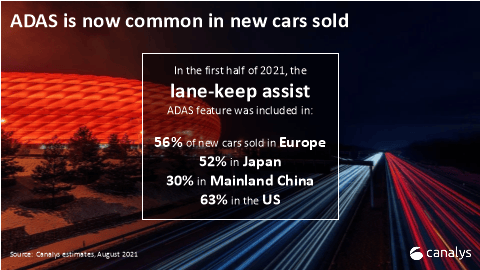New research from Canalys shows that advanced driver assistance system (ADAS) features were installed in just 10% of the 1 billion cars in use worldwide at the end of 2020. A third of new cars now sell with ADAS features in major markets such as Mainland China, Europe, Japan, and the US, but it will be several years before they are installed in half of all cars on the world’s roads.
ADAS features include adaptive cruise control, lane-keep assist, automatic emergency braking, and blind-spot alert. Using sensors and cameras, the features can actively keep a vehicle a set distance from another vehicle in front, keep a vehicle centered in its lane, bring a vehicle to a complete stop in an emergency, identify other vehicles or pedestrians approaching and more.
DAS in new cars rere
ADAS features are increasingly available as standard or as an option in new mainstream cars and even entry-level models. As an example, research from Canalys shows that the lane-keep assist feature, which when activated provides steering assistance to keep a vehicle in its lane, was installed in 56% of new cars sold in Europe in the first half of 2021, 52% in Japan, 30% in Mainland China and 63% in the US. Canalys has detaileded for all ADAS features included in new cars, by the major market on a quarterly basis.
“The inclusion of ADAS features in new cars will have a positive effect on road safety, reducing the number of accidents and thus fatalities, as most accidents are caused by driver distraction or error. ADAS features work actively to keep drivers, passengers and other road users safe,” said Chris Jones, Chief Analyst for automotive at Canalys. “But while the penetration of these driver assistance features in new cars is growing at a good rate, given that the average age of cars in use is over 12 years old, and fewer than 75 million cars will be sold in 2021, it will take many years before even half of the one billion cars in use globally have the features.”
ADAS in debanye aha cars in use
“At the end of 2020, Canalys estimates there were 1.05 billion cars in use around the world. But the key ADAS features were only installed in approximately 10%,” said Jones. “Assuming the total number of cars in use remains at around the one billion mark this decade, this is an incredible long-term opportunity for carmakers and particularly their ADAS technology suppliers and partners. 900 million cars on the road currently do not have ADAS features.
“Retrofitting ADAS features into older vehicles is not an option – the safety benefits must come in new cars. The ADAS opportunity over the next decade and beyond is huge,” said Sandy Fitzpatrick, VP at Canalys. “Economies of scale will bring down the price of the sensors required for ADAS, but despite this, Canalys currently predicts that only around 30% of cars in use will have ADAS features in 2025 and around 50% in 2030. Carmakers that can include them as standard in all their new vehicles, without a big price premium, will have a competitive advantage.”
The mandatory inclusion of ADAS in new cars will help increase penetration. Scrappage schemes to remove older, more polluting, less safe cars from the roads will also help. But stronger communication, demand-generation and education about the benefits of ADAS are key – buyers need to look for cars with ADAS, the features must be easy to use, they must enhance not inhibit the driving experience, and drivers must trust and use the features.
Unfortunately, with recent component shortages and the impact of the pandemic, the automotive industry has experienced a huge amount of disruption in the last 18 months. With long wait times for new cars, the used car market has had a new lease of life. With statistically less ADAS in used cars, the growth in ADAS penetration will be affected in the short term.
IHE Ị GA-Ewepụ na edemede a:
- “But while the penetration of these driver assistance features in new cars is growing at a good rate, given that the average age of cars in use is over 12 years old, and fewer than 75 million cars will be sold in 2021, it will take many years before even half of the one billion cars in use globally have the features.
- As an example, research from Canalys shows that the lane-keep assist feature, which when activated provides steering assistance to keep a vehicle in its lane, was installed in 56% of new cars sold in Europe in the first half of 2021, 52% in Japan, 30% in Mainland China and 63% in the US.
- “The inclusion of ADAS features in new cars will have a positive effect on road safety, reducing the number of accidents and thus fatalities, as most accidents are caused by driver distraction or error.

















![Ụgbọ oloko Hyperloop nke China: Nleba anya na Ọdịnihu nke Ụgbọ njem 15 Akụkọ Njem Nlegharị anya | Ụlọ & Mba Ụgbọ oloko Hyperloop China [Foto: Teknụzụ Ụgbọ njem Hyperloop]](https://eturbonews.com/cdn-cgi/image/width=145,height=100,fit=crop,quality=80,format=auto,onerror=redirect,metadata=none/wp-content/uploads/2024/02/180720163348-hyperlooptt-china-capsule.jpg)





